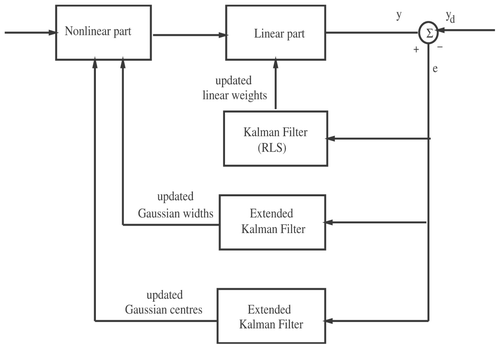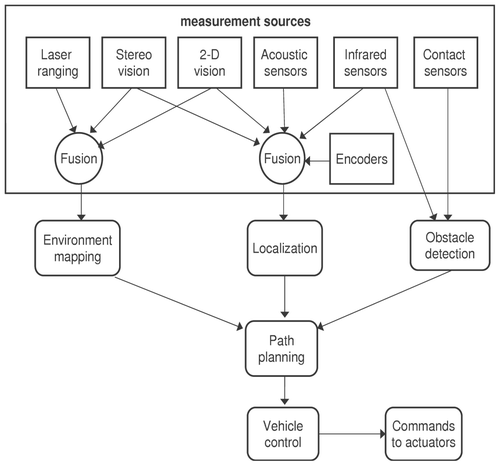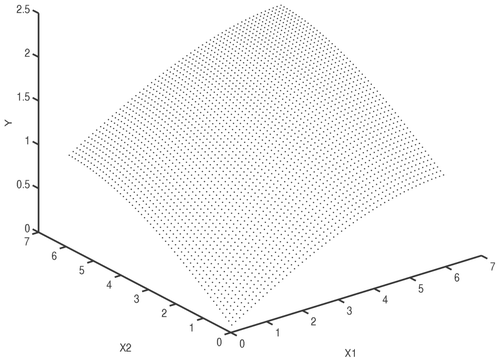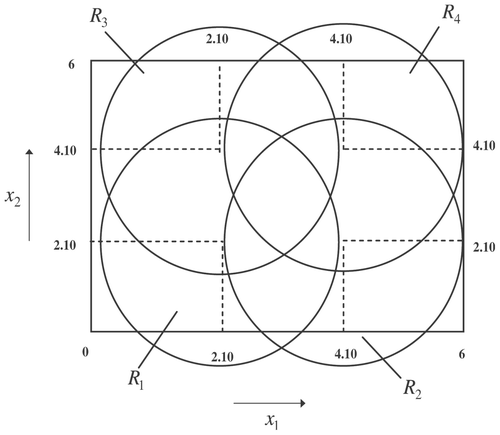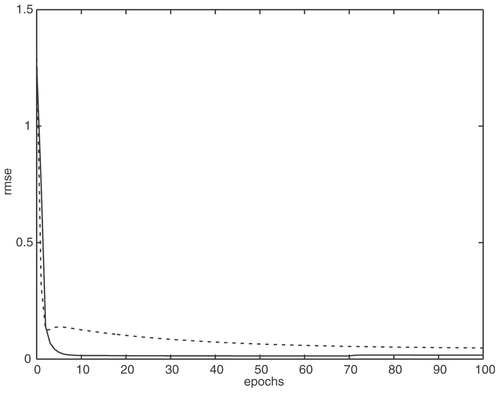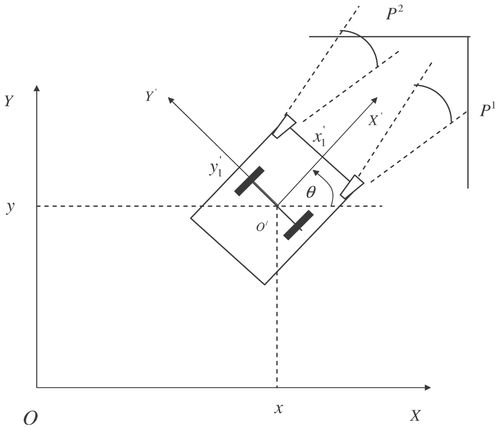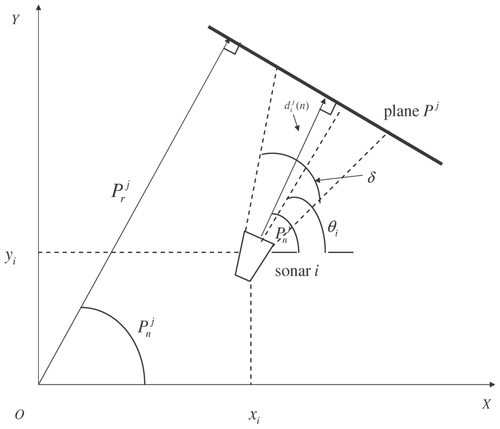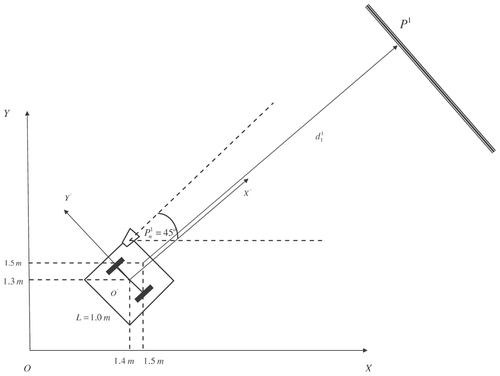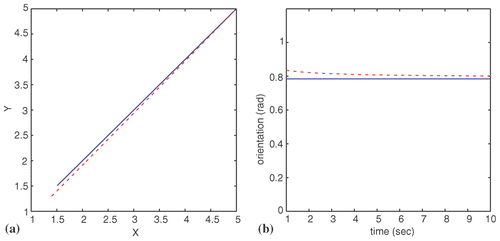Abstract
Extended Kalman Filtering (EKF) is proposed for: (i) the extraction of a fuzzy model from numerical data; and (ii) the localization of an autonomous vehicle. In the first case, the EKF algorithm is compared to the Gauss–Newton nonlinear least-squares method and is shown to be faster. An analysis of the EKF convergence is given. In the second case, the EKF algorithm estimates the state vector of the autonomous vehicle by fusing data coming from odometric sensors and sonars. Simulation tests show that the accuracy of the EKF-based vehicle localization is satisfactory.
1. Introduction
The Extended Kalman Filter (EKF) is an incremental estimation algorithm that performs optimization in the least-mean-squares sense and has been successfully applied to neural networks training and to data-fusion problems. In this paper, the EKF is employed for: (i) the extraction of a fuzzy model from numerical data; and (ii) for the localization of an autonomous vehicle by fusing data coming from odometric and sonar sensors.
In the first case, the EKF algorithm is used to estimate the parameters of a fuzzy model that approximates a nonlinear surface. It is known that the EKF algorithm is particularly successful compared to first-order gradient-descent methods with error back-propagation Citation1. In this paper, it is shown that EKF training is also faster than second-order gradient methods such as the pure Gauss–Newton algorithm. The EKF does not wait to process the entire data set before updating the parameter estimates . Instead, it processes the data incrementally and updates
after each training example is picked. Thus, the method is suitable for large data sets and real-time operation Citation2,Citation3. In the second case, the EKF is used for the localization of an autonomous vehicle that moves in a workspace defined by planar surfaces Citation4. The EKF performs fusion of the data that come from odometric and sonar sensors. EKF-based sensor fusion provides satisfactory localization of the mobile robot and enables the application of nonlinear steering control.
The structure of the paper is as follows. In Section 2, common methods for fuzzy model estimation are presented. The Gauss–Newton method for nonlinear least-squares identification is explained. In Section 3, nonlinear estimation with the use of EKF is presented. In Section 4, the problem of data fusion with the use of EKF is analysed. EKF-based data fusion for vehicle localization is introduced. In Section 5, simulation tests are provided. The EKF algorithm is used for the estimation of a nonlinear model as well as for the localization of an autonomous vehicle with the use of data from different sensors. Finally, in Section 6, concluding remarks are stated.
2 Fuzzy modelling issues
2.1 Local linear fuzzy models
Assume that data from an unknown function y = f(x 1, x 2, …, xn ) are observed. The aim is to use these data to construct an appoximation [fcirc](x 1, x 2, …, xn ). In fuzzy modelling [fcirc](x) is represented as a collection of fuzzy IF – THEN rules. The Takagi–Sugeno rule-base model is considered Citation5:
2.2 Common methods for fuzzy model estimation
Parameter estimation using the backpropagation algorithm can be slow. Thus, nonlinear least-squares methods, such as Gauss–Newton, Levenberg–Marquardt and the Extended Kalman Filter (EKF) are more suitable Citation5. It is assumed that parameters of the nonlinear system do not change with time. Thus, the parameters vector of the physical system measured at instant k − 1 is θ(k − 1) and equals the parameters vector measured at instant k. Therefore, θ(k) = θ(k − 1). It is also assumed that the order of the physical system and of the fuzzy model is the same, i.e. they contain the same number of parameters. Finally, the following notation is used: y(k) is the output of the fuzzy model at instant k, x(k) is the input vector of the fuzzy model at instant k, and d(k) is the output of the physical system at instant k. The difference between d(k) and y(k) is denoted by e(k).
The Gauss–Newton method uses a Taylor series expansion to approximate the nonlinear model and then employs ordinary least squares to estimate the model's parameters:
The derivative of E with respect to θ is . The minimum condition
gives the parameters update law
3 Fuzzy model estimation using EKF
The EKF was initially conceived as a method for estimating parameters from nonlinear measurements that are generated in real time. The basic idea of the method is to linearize each new measurement around the current value of the estimate and treat the measurement as if it was linear. The EKF for fuzzy models generation is a generalization of the well-known Recursive Least Squares (RLS) algorithm Citation6. The same assumptions about the nonlinear system and its fuzzy model as in Section 2.2 are made. The extended Kalman filter equations are derived by expanding the nonlinear function around the current estimate parameter vector. This means that at each step of the algorithm, the regressor vector is substituted by the gradient of the estimated output, i.e.
3.1 Fuzzy model estimation using EKF
The block diagram of the EKF training is shown in . In the case of a fuzzy model, there are three groups of parameters to be learned from the numerical data: the linear weights, the nonlinear centres, and the nonlinear spreads Citation7.
To reduce computation overhead, which is due to large matrix dimensionality, three separate Kalman filter algorithms are employed, i.e. for the calculation of the linear weights, centres and spreads of the membership functions, respectively.
Step 1: Optimizing the linear weights . Since the parameters
are linear, the elements of the gradient matrix Jw
of the parameters
appearing in the THEN part of the rule are
Step 2: Optimizing the centres of the membership functions. The gradient with respect to the centre
is
Step 3: Optimizing the spreads of the membership functions. The gradient with respect to the spread
is
4 Data fusion with the use of extended Kalman filtering
The paper will also investigate the application of EKF to the fusion of data that come from different sensors. Sensor fusion algorithms can be classified into three different groups: (i) fusion based on probabilistic models; (ii) fusion based on least-squares techniques (e.g. Kalman Filtering); and (iii) intelligent fusion (e.g. fuzzy logic) Citation8. This paper is concerned with case (ii).
4.1 Review of the Kalman filter for the linear state-measurement model
A dynamical system is assumed to be expressed in the form of a state model Citation9:
Now, the problem of interest is to estimate the state x(k) based on the measurements z(1), z(2), …, z(k). Actually, this is a linear minimum-mean-squares estimation problem (LMMSE) which is solved recursively, i.e. ◯(k + 1) = a n+1 (◯ (k), z(k + 1)). The process and output noise are white, and their covariance matrices are given by: E[w(i)wT (j)] = Qδ (i − j) and E[v(i)vT (j)] = Rδ (i − j). The initial value of the state vector x(0), the initial value of the error covariance matrix P(0), is unknown, and an estimation of it is considered, i.e. ◯(0) = a guess of E[x(0)], and [Pcirc](0) = a guess of Cov[x(0)]. For the initialization of matrix P, one can set [Pcirc] (0) = λI, with λ > 0.
The Kalman filter can be broken down into two parts: (i) time update and (ii) measurement update. The first part employs an estimate ◯ −(k) of the state vector x(k) made before the output measurement z(k) is available (a priori estimate), i.e. when the set of measurements is Z − = lcub;z(1), …, z(k − 1)rcub;. The second part provides an estimate ◯(k) of x(k) after z(k) has become available (a posteriori estimate), when the set of measurements becomes Z = lcub;z(1), …, z(k)rcub;.
The associated estimation errors are defined by e
−(k) = x(k) − ◯
−(k) = the a priori error, and e(k) = x(k) − ◯(k) = the a posteriori error. The estimation error covariance matrices associated with ◯
−(k) and ◯(k) are P
−(k) = Cov[e
−(k)] = E[e
−(k)e
−(k)
T
] and P(k) = Cov[e(k)] = E[e(k)e
T
(k)]. From the definition of the trace of a matrix, the mean-square error of the estimates can be written as MSE(◯
−(k)) = E[e
−(k)e
−(k)
T
] = tr(P
−(k)) and MSE(x(k)) = E[e(k)e
T
(k)] = tr(P(k)). Finally, the linear Kalman filter equations are equivalent to
Equationequation (5).
Measurement update:
Time update:
4.2 Extended Kalman filter for the nonlinear state-measurement model
The following nonlinear time-invariant state model is now considered Citation9:
Measurement update: Acquire z(k) and compute | |||||
Time update: Compute | |||||
4.3 EKF-based data fusion for vehicle localization
The role of multi-sensor fusion for mobile robot localization is shown in . Systems for vehicle localization can be classified in two main categories Citation4:
Relative localization, which is realized through sensors measuring internal parameters of the vehicle, such as position, velocity, and angular velocity. Typical internal sensors are optical incremental encoders, which are fixed to the axes of the driving wheels and the steering axis of the vehicle. | |||||
Absolute localization, which is performed using sensors that collect data from the vehicle's environment. A set of sonars is generally used as external sensor devices. Sonars are fixed to the vehicle and measure the distance with respect to obstacles and surfaces in its workspace. | |||||
Encoder measurements are prone to error accumulation and therefore introduce uncertainty in the vehicle's localization. Moreover, distance measurements from acoustic sensors are subject to uncertainty, which is expected to be significant when the measurement is taken far from the landmarks. Sonar measurements may be affected by white Gaussian noise and also by crosstalk interferences and multiples echoes. Extended Kalman Filtering is used to fuse the measurements from the various sensors as the robot moves, and statistically minimize the error in the estimation of the vehicle's state vector.
5 Simulation results
5.1 Fuzzy model estimation using EKF
EKF was employed to extract fuzzy rules from numerical data. The function y = sin(0.25x
1) + sin(0.25x
2) was used as a test case (
). The training set contained N = 3000 noise-free triplets (x
1i
, x
2i
, y, i = 1,…, 3000). The input vector [x
1, x
2]
T
was uniformly distributed in the interval [0, 6] × [0, 6]. Following the analysis in Section 2.1, the nonlinear surface was approximated by four local models. The centres of these local models and j = 1, 2, 3, 4 were initialized as follows:
,
,
,
,
,
,
. The spread of the membership functions is denoted by v and was set to v = 3. The parameters appearing in the THEN part were all initialized to 0. After training, the following rules were identified ():
Remark
Regarding convergence, it is known that the speed of EKF training is better than that of the LMS algorithm Citation3. Our simulation tests show that the EKF is also faster than the pure Gauss–Newton method due to setting λ < 1 in the initial training cycles. This is demonstrated in .
The EKF algorithm resembles asymptotically to a gradient method with diminishing stepsize. It has been proved (Citation2,Citation3) that for λ = 1 and for a large number of learning steps k, the EKF iteration can be written approximately as
Proposition
It is assumed that the Jacobian matrix J(θ, x) is full rank and that for some L > 0 || Ji
(x)y(θ, x) – Ji
(x′)y(0,x′) || ⩽ L || x – x′ ||, ∀x, x′ ∈ R
n
holds, where Ji
with i = 1, 2, …, N is the ith row of the Jacobian matrix, which is associated with the ith training sample. If, for the constant c > 0, the forgetting factor λq
, at the qth epoch, satisfies , then the EKF converges. This proposition demonstrates that as the number of epochs q increases and
, the convergence condition is λq
→ 1.
In the simulation tests, the initial value of λ was chosen to be 0.999. It is known that the memory of the RLS algorithm is approximated by . Since the EKF consists of local RLS algorithms, choosing λ = 0.999 means that only 1000 out of the 3000 triplets gi
are taken into account in the first steps of the EKF training. This explains why the EKF algorithm converges faster than the Gauss–Newton method. An oscillatory behaviour of the algorithm and possible divergence can be avoided if the gain λ is progressively raised to 1. After 200 epochs, the RMSE of the EKF algorithm was 1.4e – 2. In the case of the Gauss–Newton method, the RMSE obtained after 200 epochs was 4.43e – 2. To reduce the RMSE further, a greater number of local fuzzy models is required.
5.2 EKF-based sensor fusion for autonomous vehicle localization
A unicycle robot is considered. Its continuous-time kinematic equation is given by
The inertial coordinates system OXY is defined. Furthermore, the coordinates system O′X′Y′ is considered ( ). O′X′Y′ results from OXY if it is rotated by an angle θ (). The coordinates of the centre of the wheels axis with respect to OXY are (x, y), while the coordinates of the sonar i that is mounted on the vehicle, with respect to O′X′Y′, are x i ′, y i ′. The orientation of the sonar with respect to OX′Y′ is θ i ′. Thus, the coordinates of the sonar with respect to OXY are (xi , yi ), and its orientation is θi with
The sonar i is at position xi
(k), yi
(k) with respect to the inertial coordinates system OXY, and its orientation is θi
(k). Using the above notation, the distance of the sonar i, from the plane Pj
is represented by ,
(see
):
In this simulation test, the number of sonar is taken to be n
s = 1, and the number of planes n
p = 1, so the measurement vector becomes . The extended Kalman Filter (EKF) is obtained if the kinematic model of the vehicle is linearized about the estimates ◯(k) and ◯
−(k) and the control input U(k) is applied.
The measurement update of the EKF is
vehicle's initial position in OXY: x(0) = 1.4m, y(0) = 1.3m, θ(0) = 45.0°; | |||||
position of the sonar in O′X′Y′: x 1′ = 0.5 m, y 1′ = 0.5 m, θ1′ = 0°; | |||||
position of the plane P
1: | |||||
state noise w(k) = 0, [Pcirc](0) = diag[0.1, 0.1, 0.1], and R = diag[10−3, 10−3, 10−3, 10−3]; | |||||
Kalman Gain K(k) ϵ R 3×4; and | |||||
desirable trajectory: starts at xd (0) = 1.5, yd (0) = 1.5, and forms a 45° with the OX axis. | |||||
6 Conclusions
In this paper Extended Kalman Filtering (EKF) was employed to: i) generate a fuzzy model from numerical data, and ii) estimate the location of an autonomous vehicle by fusing data that come from different sensors.
The fuzzy model of concern was a first order Takagi-Sugeno one. The EKF was compared to the pure Gauss-Newton method (unit stepsize) and simulation tests showed that the EKF is faster. The EKF training does not wait to process the entire data set before it updates the parameter estimates. Instead the method cycles through the training examples and updates the parameters after each example is processed. A further advantage of the EKF training is that estimates of the parameters become available as training data are accumulated, making the approach suitable for real time operation. The convergence of the EKF was analysed with respect to the value of the forgetting factor λ. Setting λ < 1 in the first epochs of the EKF training results in rapid decrease of the RMSE. Raising λ progressively to 1 assures the EKF convergence, since in that case the EKF becomes equivalent to a Gauss-Newton algorithm with diminishing step size.
Regarding the autonomous vehicle localization, the EKF-based data fusion gave satisfactory results. The EKF provided an estimation of the vehicle's position and orientation by fusing data that come from odometric sensors (incremental encoders) and sonars. Thus nonlinear control of the vehicle was successfully applied. Simulation tests showed that in the case of relatively simple trajectories the accuracy of the localization stays within acceptable levels.
References
- Watanabe , K. and Tzafestas , S. G. 1990 . Learning algorithms for neural networks with the Kalman Filters . Journal of Intelligent Robotic Systems , 3 : 305 – 319 .
- Bertsekas , D. P. 1996 . Incremental least squares methods and the extended Kalman Filter . SIAM Journal of Optimization , 6 : 807 – 822 .
- Bertsekas , D. P. 1995 . Nonlinear Programming , Belmont, MA : Athena Scientific .
- Jetto , L. , Longhi , S. and Venturini , G. 1999 . Development and experimental validation of an adaptive extended Kalman Filter for the localization of mobile robots . IEEE Transactions on Robotics and Automation , 15 : 219 – 229 .
- Jang , J. -S.R. , Sun , C. -T. and Mizutani , E. 1997 . Neurofuzzy and soft-computing. A Computational Approach to Learning and Machine Intelligence , Englewood Cliffs, NJ : Prentice-Hall .
- Haykin , S. 1991 . Adaptive Filter Theory , Englewood Cliffs, NJ : Prentice-Hall .
- Chak , C. K. , Feng , G. and Mia , J. 1998 . An adaptive fuzzy neural network for MIMO system model approximation in high dimensional spaces . IEEE Transactions on Systems, Man and Cybernetics—Part B: Cybernetics , 28 : 436 – 446 .
- Luo , R. C. and Kay , M. G. 1989 . Multisensor integration and fusion in intelligent systems . IEEE Transactions on Systems, Man and Cybernetics , 19 : 901 – 931 .
- Kamen , E. W. and Su , J. K. 1999 . Introduction to Optimal Estimation , London : Springer .
- Rigatos , G. G. , Tzafestas , S. G. and Evangelidis , G. A. 2001 . IEE Proceedings: Control Theory and Applications 169 – 179 .
- Rigatos , G. G. 2003 . Fuzzy stochastic automata for intelligent vehicle control . IEEE Transactions on Industrial Electronics , 50 : 76 – 79 .
- Oriolo , G. , De Luca , A. and Vendittelli , M. 2002 . WMR control via dynamic feedback linearization: Design, implementation and experimental validation . IEEE Transactions on Control Systems Technology , 10 : 835 – 852 .
